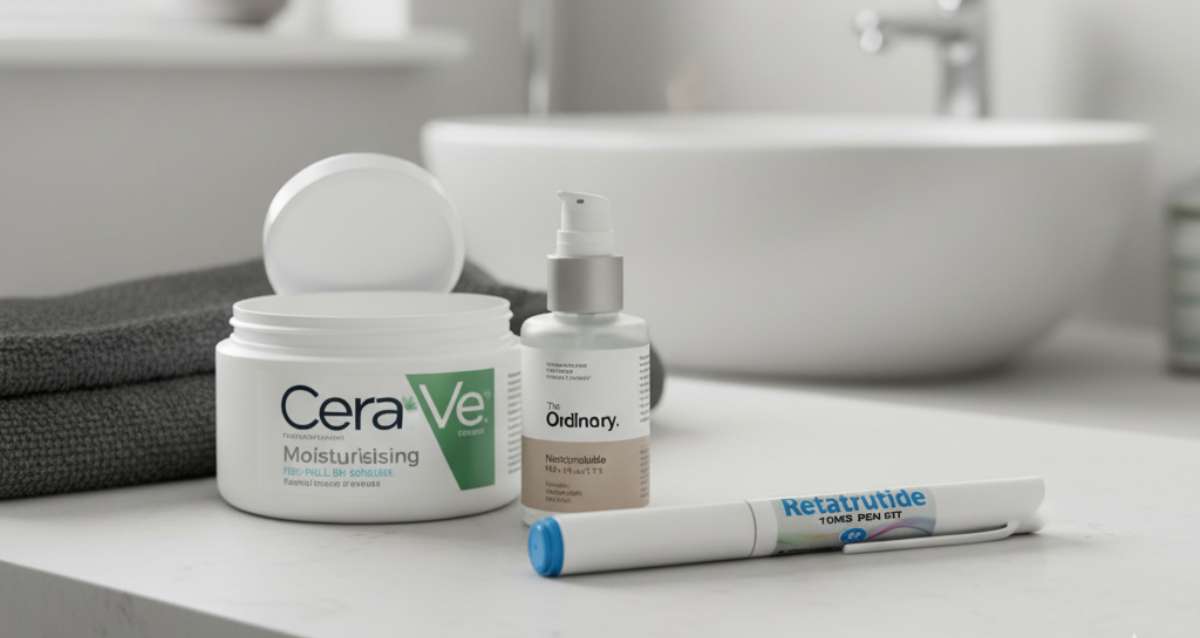Retatrutide Half-Life & Washout The Length of Time in Your System
‘How long do I keep it in my body’ is one of the most common and sensible questions that patients can raise whenever a new weight-loss and metabolic therapy is emerging into the world of recognition. As Retatrutide is a triple agonist (GLP-1, GIP, and glucagon receptor), special attention should be paid to the Retatrutide half-life & washout period because of its unusual pharmacology.
Here, we deconstruct the clinical, describe the workings of half-life on dosing, describe what happens when you stop taking Retatrutide and evergreen UK guidance. The main idea at RetatrutidePens.com is transparency and that is why this blog is a combination of science, trial results and practical rules of thumb.
What is Retatrutide?
Retatrutide is an example of a triple-agonist peptide drug, which activates GLP-1, GIP and glucagon receptors. This special profile has proved:
- Phase 2 clinical trials show an average of 24% weight loss in 48 weeks.
- Better blood sugar balance, lowering of cholesterol and strengthening of metabolism.
- Longer effect duration than previous GLP-1 agonist or dual agonist medications.
The Retatrutide half-life & washout are also significant due to its long half-life, which is essential to patient safety, tolerability, and to schedule treatment breaks.

Getting to Know Half-Life: The Basics
The half-life of a drug is the period of time it takes to get half of the amount of the substances out of your system. With Retatrutide:
- There is clinical evidence of a half-life of approximately 6–8 days.
- This prolonged half-life means that at least once a week, one can take the drug, and it is convenient in contrast to injecting every day.
- It also implies that, in case there are side effects they may last longer.
Speaking of Retatrutide half-life & washout, it is necessary to keep in mind that several half-life cycles will pass before the drug is finally out of your body.
Retatrutide Half-Life in Clinical Trials
Early phase 2 trials were monitored with a very close approach to the pharmacokinetics of Retatrutide:
- Absorption: Retatrutide is slowly absorbed after subcutaneous injection with a peak in the blood within the range 24–72 hours.
- Elimination: It is primarily eliminated by metabolic breakdown, but not by renal excretion.
- Duration: It has a half-life of 6–8 days, meaning that it remains active much longer than the date of injection.
This information is the foundation of how Retatrutide can be used once a week with regular success.
Washout Period: How Long Before it is Gone?
The washout period is the time that it takes a drug to exit your body. For Retatrutide:
- The general time of taking a drug to have it close to being eliminated is 5 half-lives.
- Retatrutide has half-life of 6–8 days, and may require 30–40 days to clear completely.
- The effects can persist as long as 6 weeks following the final dose.
This implies that the good (and in some cases side effects) of therapy accumulate gradually when you stop treatment, and do not disappear instantly.
The Importance of the Washout Period
Knowledge of Retatrutide half-life & washout is applicable in the real world:
- Missed doses – Missing an injection will leave you with Retatrutide in your system days later, which will provide a buffer.
- Drug replacement – Physicians usually suggest a 1–2 months washout between two GLP-1 or metabolic drugs.
- Side effect management – The slow washout also may persist weeks with such symptoms as nausea or skin sensitivity.
- Surgery or medical events – The awareness of the duration of lingering can allow surgeons and anaesthetists to plan safer operations.

Missed Dose Guidance
If you forget a dose:
- In 4 days: Take it as early as possible.
- After 4 days: Do not take anything, wait until you next take your dose.
Always abstain from overdose, the half-life is too long.
This missed dose principle has a direct connection with the Retatrutide half-life & washout principle.
Retatrutide Compared to Other GLP-1 Drugs
| Drug | Half-Life | Washout Period | Dosing Frequency |
| Semaglutide | 7 days | 35–40 days | Weekly |
| Tirzepatide | 5 days | 25–30 days | Weekly |
| Retatrutide | 6–8 days | 30–40 days | Weekly |
The half-life of Retatrutide lies between semaglutide and tirzepatide, although its triple-agonist effect makes its washout have a greater clinical impact.
Practical UK Guidance
- Time is key: Patience is required—the process of obtaining results is regular and persists over time as the half-life is long.
- Budget time-out: In case you need a break, keep in mind that it may require more than a month to have a clean-out.
- Be alert on transparency: Buy only Retatrutide through the known sellers such as RetatrutidePens.com to find authentic products.
We have only real product at RetatrutidePens.com at Wilsons Park Monsall Road, Manchester, M40 8WN.
For help, contact us at:
📧 info@retatrutidepens.com
📞 0330-133-5910
Retatrutide Half-Life & Washout: Frequently Asked Questions
Q1. Retatrutide is retained in your system how long?
Until 30–40 days, depending on the metabolism and the dose.
Q2. What will become of me should I suddenly quit taking Retatrutide?
The medication will clear gradually thus weight or sugar management might lag on weeks.
Q3. Are there any long-lasting side effects?
Yes. Because of the long Retatrutide half-life & washout, the symptoms could persist at the washout stage.
Q4. What is the significance of washout to UK patients?
It has effects on NHS monitoring, prescription modification and safety of private use.

It is considered one of the highly dependable and protracted metabolic treatment choices in the present day due to the Retatrutide half-life & washout profile. This is due to its long half-life hence its ability to be taken once a week but also subjects the patient to the month washout.
We are of the view that at RetatrutidePens.com, honesty and clarity give power to patients. Knowing the Retatrutide retention in your system, it is easy to make a decision regarding your treatment.
Only found at RetatrutidePens.com.

